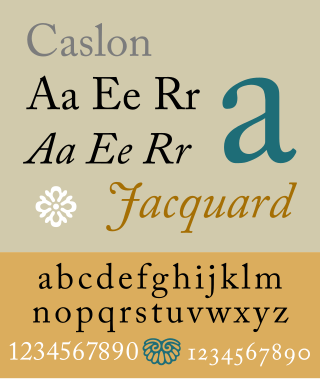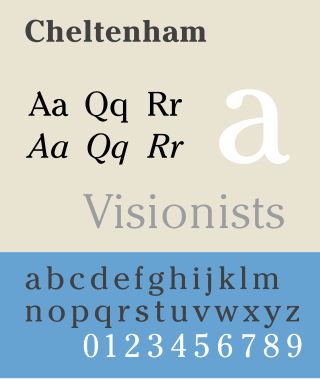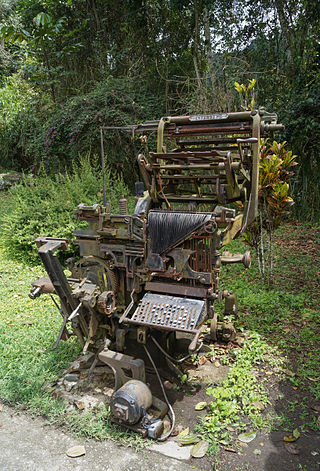Related Research Articles

Franklin Gothic and its related faces are a large family of sans-serif typefaces in the industrial or grotesque style developed in the early years of the 20th century by the type foundry American Type Founders (ATF) and credited to its head designer Morris Fuller Benton. "Gothic" was a contemporary term meaning sans-serif.

Caslon is the name given to serif typefaces designed by William Caslon I (c. 1692–1766) in London, or inspired by his work.

Oswald Bruce Cooper was an American type designer, lettering artist, graphic designer, and teacher of these trades.

Cheltenham is a typeface for display use designed in 1896 by architect Bertram Goodhue and Ingalls Kimball, director of the Cheltenham Press. The original drawings were known as Boston Old Style and were made about 14" high. These drawings were then turned over to Morris Fuller Benton at American Type Founders (ATF) who developed it into a final design. Trial cuttings were made as early as 1899 but the face was not complete until 1902. The face was patented by Kimball in 1904. Later the basic face was spun out into an extensive type family by Morris Fuller Benton.

Goudy Old Style is an old-style serif typeface originally created by Frederic W. Goudy for American Type Founders (ATF) in 1915.

News Gothic is a sans-serif typeface designed by Morris Fuller Benton, and was released in 1908 by his employer American Type Founders (ATF). The typeface is similar in proportion and structure to Franklin Gothic, also designed by Benton, but lighter.

Stephenson Blake is an engineering company based in Sheffield, England. The company was active from the early 19th century as a type founder, remaining until the 1990s as the last active type foundry in Britain, since when it has diversified into specialist engineering.
Bauersche Gießerei was a German type foundry founded in 1837 by Johann Christian Bauer in Frankfurt am Main. Noted typeface designers, among them Lucian Bernhard, Konrad Friedrich Bauer, Walter Baum, Heinrich Jost, Imre Reiner, Friedrich Hermann Ernst Schneidler, Emil Rudolf Weiß, and Heinrich Wienyck, designed typefaces for the company.

Linn Boyd Benton was an American typeface designer and inventor of technology for producing metal type.
Sidney Clyde Gaunt was an American type designer and artist.
Barnhart Brothers & Spindler Type Foundry was an American company founded as the Great Western Type Foundry in 1873. It became Barnhart Brothers & Spindler ten years later. It was a successful foundry known for innovative type design and well designed type catalogs. Oz Cooper, Will Ransom, Robert Wiebking, and Sidney Gaunt all designed for BB&S. It was bought out by American Type Founders in 1911 with the proviso that the merger would not take effect for twenty years, so that the employees would have a chance to find new work or retire over time. The foundry was finally closed in 1933.
Robert Wiebking (1870–1927) was a German-American engraver typeface designer who was known for cutting type matrices for Frederic Goudy from 1911 to 1926.
Sol Hess was an American typeface designer. After a three-year scholarship course at Pennsylvania Museum School of Industrial Design, he began at Lanston Monotype in 1902, rising to typographic manager in 1922. He was a close friend and collaborator with Monotype art director Frederic Goudy, succeeding him in that position in 1940. Hess was particularly adept at expanding type faces into whole families, allowing him to complete 85 faces for Monotype, making him America's fourth most prolific type designer. While he was with Monotype, Hess worked on commissions for many prominent users of type, including, Crowell-Collier, Sears Roebuck, Montgomery Ward, Yale University Press, World Publishing Company, and Curtis Publishing for whom he re-designed the typography of their Saturday Evening Post.

The Intertype Corporation produced the Intertype, a hot metal typesetting machine closely resembling the Linotype, and using the same matrices as the Linotype. It was founded in New York in 1911 by Hermann Ridder, of Ridder Publications, as the International Typesetting Machine Company, but purchased by a syndicate for $1,650,000 in 1916 and reorganized as the Intertype Corporation.
Joseph Warren Phinney was an American printer, type designer, and business executive. Phinney began his career at the Dickinson Type Foundry in Boston where he designed type and worked in management, eventually becoming owner. He was a key player in arranging the merger of twenty-six large foundries to form the American Type Founders Company in 1892, becoming both manager of the Boston branch and head of the design department, where he oversaw the consolidation of type faces following the merger. Though his own designs were largely derivative, Phinney took a great interest in type and its history and throughout his tenure at A.T.F. he sought to preserve and protect that company's legacy, as for instance, when he oversaw the re-introduction of Binny & Ronaldson's 1796 type design, Roman No. 1, as Oxford in 1892, or when he purchased Frederick W. Goudy's first type design, Camelot, in 1896. He stayed with A.T.F. for the rest of his career, passing the role of design head to Morris Fuller Benton and becoming senior vice-president. Phinney retired shortly before the company fell upon hard times during the Great Depression and died in 1934.

The Amsterdam Type Foundry was a type foundry based in Amsterdam, Netherlands.
Edwin W. Shaar was an American writer, graphic artist and typeface designer. He was an assistant art director at Lanston Monotype before becoming director of the type design program at Intertype. He also designed Phototypesetting faces.
References
- Eckman, James, The Inland Type Foundry, 1894-1911, PAGA, vol. 8, pp. 31–52, 1960.
- "The Inland Type Foundry". Luc Devroye. 1999-02-22. Retrieved 2011-11-18.
- ↑ Eckman, James, The Inland Type Foundry, 1894-1911, PAGA, vol. 8, pp. 31-52, 1960.
- ↑ List of foundry types taken from these sources:
- Eckman, James, The Inland Type Foundry, 1894-1911, PAGA, vol. 8, pp. 31-52, 1960.
- McGrew, Mac, American Metal Typefaces of the Twentieth Century, Oak Knoll Books, New Castle Delaware, 1993, ISBN 0-938768-34-4.
- Jaspert, W. Pincus, W. Turner Berry and A.F. Johnson, The Encyclopedia of Type Faces, Blandford Press Lts.: 1953, 1983, ISBN 0-7137-1347-X.
- ↑ Faces marked with an asterisk appeared in the 1906 Specimen Book & Catalog. A price list of printers' supplies shoing types and rules, (Inland Type Foundry, Chicago, St. Louis, and N.Y.C.) though they may have been produced earlier. The 1906 book also has a listing for Monkey Dashes which appear to be perfectly ordinary dashes wider than 2 Ems.